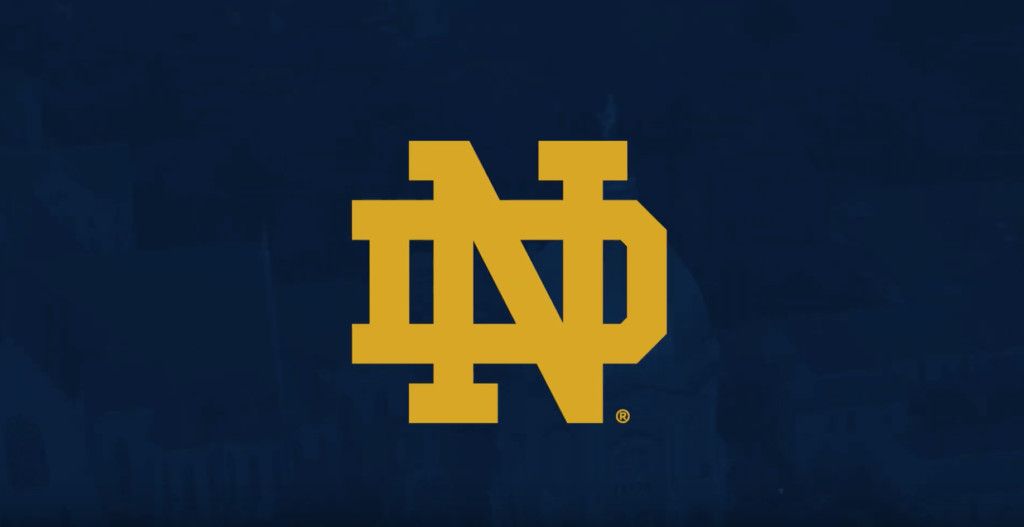Feb. 6, 2004
By Pete LaFleur
It’s rare that an intact-returning infield – from a successful program, no less – features new starters at three positions. But such is the case with Notre Dame’s 2004 squad, with senior All-America second baseman Steve Sollmann representing the only infielder who is slated to open at the same spot in the upcoming campaign.
Notre Dame’s 2002 College World Series team featured Paul O’Toole at catcher, Joe Thaman at first base, Sollmann at second base, Javi Sanchez at shortstop and Andrew Bushey at third base. Two years later, the Irish likely will open the season with only Sollmann at the same position (despite Thaman and Sanchez still being on the roster). Even more noteworthy is the fact that Sollmann and Sanchez (at catcher) are the only infield-area starters from the 2003 squad who are slated to start at the same position in 2004.
The probable position changes involve the shifting of four players, as sparked by the emergence of sophomore Greg Lopez (Upper Arlington, Ohio) at shortstop. Lopez – a regular shortstop dating back to his tee-ball days – was a part-time starter at third base for the Irish in 2003 but earned the chance to compete for his familiar shortstop role during the 2003 fall season.
The returning starter at shortstop, junior Matt Macri (Clive, Iowa), missed the first couple weeks of fall ball with a thumb injury suffered late in the 2003 summer season. As luck would have it, Macri had spent the summer playing third base for the Brewster Whitecaps of the Cape Cod League, emerging as a top pro prospect at the hot corner.
Thus the combination of Macri’s prospects at third and Lopez’s strong play at shortstop (plus the bonus of his offensive boost) resulted in a shuffling on the left side. Junior Matt Edwards (Mechanicsville, Va.) – who split time at third and first base in 2003 – then headed across the diamond to focus on first base.
The most intriguing change has involved senior Joe Thaman (St. Louis, Mo.), who made a name for himself as one of college baseball’s top defensive first basemen during the 2001-03 seasons. Inconsistency on the offensive end prompted Thaman to follow through on an idea that he’d floated earlier in his career: a move to the mound. Now, less than two weeks from opening day, the 6-4 lefthander could find himself in the starting rotation after an impressive transition back to a position that he had not played since high school.
The new-look infield combination includes three prep shortstops (Lopez, Macri and Edwards) and one of the top defensive second basemen in all of college baseball.
“When we played in the 2002 College World Series, Stanford beat us in two very tight games,” says 10th-year Notre Dame head coach Paul Mainieri.
“Stanford made several big-time plays in the infield during those games and they had a unique situation in which all of their infielders were former shortstops. We don’t have quite that combination but Steve Sollmann is considered one of the best second basemen around and the other three are tremendous athletes, as is our catcher Javi Sanchez. So we obviously are excited to see this infield work as a unit. They could have a big impact on a lot of games this season.”
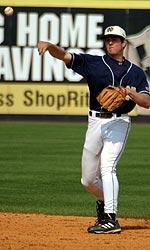
Senior Javi Sanchez has the unique dual role of starting catcher and top utility infielder.
|
Sanchez is the wildcard in the whole equation, holding a unique dual role as starting catcher and top utility infielder. If Sollmann, Lopez or Macri are forced from a game, the Irish coaching staff’s first inclination will be to shift Sanchez into any of those infield spots (with freshman catcher Sean Gaston a more-than-capable option behind the plate). Sanchez – a prep second baseman who spent most of the 2002 College World Series season as the starting shortstop, following injuries to Macri and Edwards – even could fill in at first base in a pinch.
Lopez’s emergence as a viable everyday shortstop set the dominoes in motion around the Irish infield. The six-foot, 185 pounder clearly has benefited from a productive 2003 summer and fall season, after seeing his play limited in the fall of ’02 due to a back injury.
“When I hurt my back in fall of my freshman year, I lost 10 pounds and did not have the strength you need for college baseball,” says Lopez, who went on to hit just .250 in the 2003 season while experiencing the inconsistency that is typical of a freshman season.
“After last season, I hit the weight room, my strength started to improve and that really helped with my swing.”
Lopez saw his batting average improve to .268 in the summer of ’03, all the more noteworthy because it came with wooden bats while playing for the Delaware (Ohio) Cows of the Great Lakes League. He split time with the Cows at second, shortstop and third while playing alongside fellow college shortstops Chris Gutierrez (Oklahoma State) and Angel Lopez (Ohio Dominican) to help form one of the league’s top defensive infields.
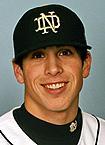
Greg Lopez is noted for his aggressive fielding skills that date back to many years of experience at the shortstop position.
|
The high-energy Lopez then sparkled during fall ball, playing error-free through the first 15 days of practice. His bat also reawakened, providing an added bonus to a defensive-oriented position.
“Shortstop always is the position where I felt most comfortable and I just was glad to get the chance to compete for the spot,” says the Academic All-America candidate (3.36 cumulative GPA).
“After struggling at times last season, I have learned what type of offensive player I need to be to help this team,” adds Lopez, who was an accomplished linedrive hitter as a prep. “My focus needs to be on moving baserunners, getting on base, working walks, lowering my strikeouts. Those are things that I feel I can do on a regular basis, in addition to getting some key hits.”
Macri counts himself among those who have been impressed with Lopez in the shortstop role.
“You saw a lot of this with Greg last season as well. He is really aggressive to the ball and usually fields and throws on the run. It’s a style that works great for him,” says Macri, who admits to a style that involves sitting back more on the ball and then showcasing his tremendous arm strength.
“Greg also has become much more consistent at the plate and has shown that he can be a tough out and good linedrive hitter. It was really exciting this fall to see the infield take shape and Greg obviously was a big part of that.”
Lopez’s slick-fielding play can be traced back to his days as a youth growing up in Arizona.
“One of our neighbors, Nick Mallis, was an older kid who was a great player and he really helped show me how to play shortstop, things like how to pick balls and move your feet,” says Lopez. “Nick ended up signing a contract with the Atlanta Braves but they discovered a medical condition that set back his career. But he had a big influence on me early on, as did my dad after we moved to Ohio when I was 11. He always was willing to drop whatever he was doing and help me with my baseball skills.”
Lopez bought into his aggressive fielding approach after attending a Chicago Cubs game when he was 14. “I watched the shortstop and the way he charged the ball and it reinforced the way I wanted to play,” he says. “I used to just stand there and let the ball come to me but I learned to be more aggressive and attack the ball, instead of letting the ball play me.”
“Greg was an outstanding linedrive hitter in high school but struggled at times, as many freshmen do. Now he’s stronger, more experienced and swings the bat well. He simply needs to have productive at-bats -by hitting in the clutch, moving runners up and drawing walks.”
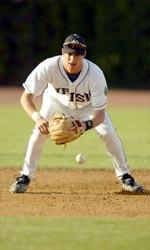
Junior Matt Macri is slated to make the move from shortstop to third base, after an impressive summer season at the hot corner while playing for the Cape Cod League’s Brewster Whitecaps.
|
Macri – the highest-rated recruit in the program’s history – could combine with Lopez for an airtight left side.
“It’s very exciting playing alongside Matt and he’s a great player,” says Lopez. “I think we will be a very tough left side of the infield and when you combine that will Edwards and Sollmann on the right side, it has the makings of a great infield.”
Despite his freshman-year elbow injury and an inconsistent sophomore season (.294, 35 RBI, 4 HR, 19 Es), Macri remains highly-regarded and was slotted 33rd on the PG/Baseball America list (Oct. ’03) of top college prospects for the 2004 draft (he was the fourth infielder on that list). BA also dubbed Macri as the BIG EAST’s “best defensive third baseman” and “infielder with the strongest arm.”
The 6-2, 190-pound Macri was one of four college shortstops who had been recruited by the Brewster general manager to fill out the 2003 Whitecaps roster (Miami’s Ryan Braun ended up not coming to Brewster after the ’03 CWS ended, with the uncertainty of being able to play shortstop). The roster also included Tulane’s Tommy Manzella and Eastern Michigan’s Brian Bixler, making for a talented – but uncertain – infield unit.
“I had played some third base in high school and with the Team USA program, so I ended up at third basically by default,” says Macri. “It gave me the chance to play every day and the more I played it, the more I liked it.
“There obviously are different angles to the ball and positioning is huge. You have to cover the bunting, which is totally new, and there are different kind of plays. But I’ve really come to like playing at third.”
Macri had talked to Mainieri during the summer about the potential position shift. “I was out with my thump injury during the start of fall practice but it was obvious that Greg had become a strong option at shortstop,” says Macri. “I wanted to get as much experience as possible playing at third, so when I came back I played there to make the full transition early on.”
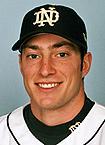
Matt Macri could provide a big boost to the Irish offense in 2004, after missing most of 2002 due to injury before an inconsistent 2003 season.
|
The fall season featured says “major-league plays” from Macri, according to Mainieri, who saw his top infield prospect flash his classic combination of glove skills, range, athleticism and arm strength.
Macri and Mainieri both know that the current Irish third baseman’s professional baseball career is dependent on his offensive production.
“I’ve put in a lot of work to becoming a more consistent hitter but my offensive role has not changed because I’m playing third base. I felt really good hitting the ball all winter and am eager for this season to start,” says Macri.
The heavy-hitting Edwards – who claims that Macri “could play any position on the field, due to his tremendous reactions, hands and arm – should show noticeable improvement at first base in 2004. Notre Dame’s 2003 RBI leader (69) endured an unusual summer with an injury-plagued Waynesboro (Va.) Generals squad, causing him to be used at all four infield positions (with just a handful of games at first).
“It was a tough summer for our team and we all filled in where we were needed – but the transition to playing first base went great this fall,” says Edwards, whose inspiring return from a broken leg early in the 2002 season included earning first team all-BIG EAST and ABCA second team all-region honors in 2003, en route to batting .376 with a team-best eight home runs, plus 16 doubles and 25 walks.
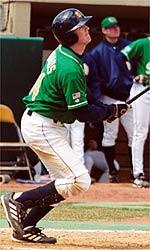
Junior corner infielder Matt Edwards hopes to again be a top run producer for the Irish in 2004, with a primary defensive focus at first base.
|
“Since coming back from Christmas, I have taken 100 throws a day and have been working most on my picks. Coach Mainieri has helped a lot with the transition, as has Joe. I’ve got my footwork down and now am just trying to keep improving my all-around defensive play.”
The 6-2, 195-pound Edwards has taken some key tips from Thaman in regards to his regular positioning.
“Joe showed me he works around the bag and it’s basically just a matter of repetition,” says Edwards. “Joe has a style where he starts with his left foot up the line, making it easier to cross over to the front of the bag. With me being righthanded, I have taken a similar approach by starting with my right foot up the line. I picked that up from Joe and it’s a very comfortable and effective style.”
Thaman the teacher gives Edwards a passing grade on his first-base progress. “Everybody is excited with Matt’s progress and he really has learned how to use the bag to his advantage,” says Thaman, “He’s getting better every day and I’ve had the chance to hit him some fungos to see how he looks. I have not seen a weakness but most of the credit goes to coach Mainieri. He’s worked a lot with Matt on the transition.”
Thaman’s switch clearly has been the most challenging, but he has encountered few bumps in the road that leads from first base to the pitcher’s mound.
“At first, I was a little tentative and didn’t know what to expect. I was trying to prove to myself, really more than anybody else, that I could still pitch,” says Thaman, a two-way players at St. Louis University High School who posted a 3.23 ERA and 7-1 record as a prep senior (with 57 strikeouts, 25 walks in 45 innings).
“I got confidence from my first outing in the fall and I maintained that confidence the entire fall. I’m very happy with the way I’ve progressed.”

Senior Joe Thaman quickly has developed into a top lefthanded pitcher with the Irish, after serving as the starting first baseman from 2001-03.
|
Thaman’s unique position shift has come under the guidance of first-year pitching coach Terry Rooney, who has credited Thaman’s quick adjustment to his “experience in pressure situations, great athleticism, ability to pound the strike zone with all three pitches and a hitter’s perspective that gives him an inherent feel for the game and the ability to make pitch-by-pitch adjustments.”
That admiration is mutual, with Thaman tossing plenty of credit to his new position coach.
“Coach Rooney has provided a fresh perspective and a lot of pitchers could get chances this spring to show what they can do,” says Thaman.
“The confidence that he instilled in me really helped with the transition. He’s a great pitching coach and can see little things that are minor adjustments but end up having a big impact on your effectiveness as a pitcher. I was not being consistent with my leg lift but we worked on it and that has helped me throw strikes more consistently.
“Coach Rooney’s philosophy involves a lot of repetition of the same motion. It really has helped lot of us get a better feel for the pitches.”
“I got confidence from my first outing in the fall and I maintained that confidence the entire fall. I’m very happy with the way I’ve progressed.”
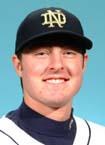
Joe Thaman’s experience as a hitter could provides unique benefits on the mound in 2004.
|
Thaman hopes to improve the Notre Dame staff’s control of the running game. “A runner should not be able to steal on lefthanded pitchers and balance is the key,” he says. “Coach Rooney has helped me with the balance and making the throw to first, so I feel pretty comfortable in that area.”
One area that has taken some extra adjustment for Thaman is defensive positioning. Irish fans can vividly remember past seasons when the imposing 6-4, 210-pound Thaman would sprint from first base to the mound area, taking charge as a throw would come in from the outfield. Now, he’s had to re-learn his defensive impulses.
“I’ve had to go back to what I learned in high school, hustling to certain spots when the ball is hit to different parts of the field,” says Thaman, whose career offensive stats with the Irish include a .279 batting average, 9 home runs, 28 doubles and 81 RBI.
“I found myself getting caught on the mound a couple times this fall. It’s just a matter of getting back to the habit of hustling to certain spots.”
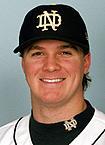
Matt Edwards and the rest of the Irish infielders are excited for the new defensive alignment in 2004.
|
As the Irish near their 2004 season opener, Edwards best summed up the team’s mindset concerning the numerous position switches.
“Everyone knows what he has to do to help the team, the things that give us the best chance to win,” says Edwards. “None of us is worried with what position we play. We care about putting together a great team that can win a lot of games.
“All of the players have a great attitude and we really like where the players have been positioned. I think you will see us develop into a great infield this season and hopefully we will help lead this team to more great accomplishments.”







